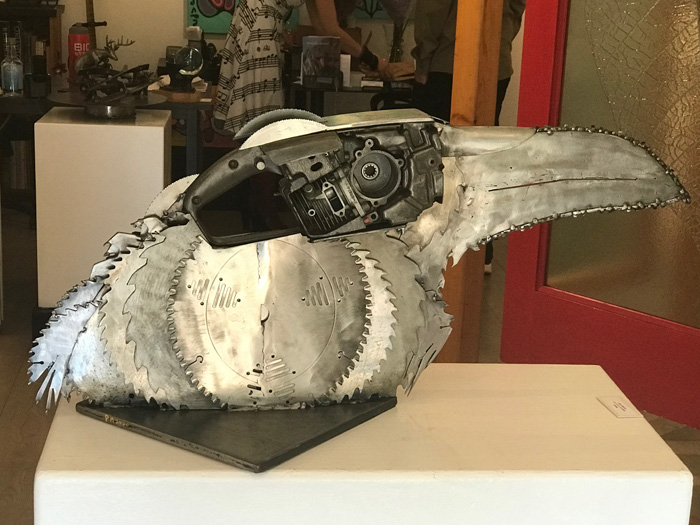Metal and stone may represent the harder, more permanent aspects of the earth element, but a show at Steffich Fine Art featuring new work by Peter McFarlane and Ron Crawford reveals there are no fixed boundaries when it comes to art.
Crawford’s modern frescoes are a place where this contemporary artist/stone mason can blend his two personas. Wall pieces made of plaster over board are both painting and sculpture, with the base material shaped, carved, sanded and painted.
Crawford is currently showing the products of two series. In Dangerous Goods the works include a grid of nails that extend out from the surface. Chasing Shadows extends the process by drilling down into the surface and embedding it with sculptural dollops. Here Crawford works in pairs, with the marks and the surface treatment on one piece creating and informing the other. Some of the works also have a faint grid of lines overlaid onto the surface, which contrasts with the organic shapes emerging through.
“There is a logic to working them, but at the same time I can’t really control what the form makes coming out, and I don’t want to, or the splashes and marks it makes coming out. That’s the random element,” Crawford explained during Friday night’s opening reception.
Chasing Shadows surfaces resemble mud flats at low tide. Dark grey paint embraces hints of undertones — in one case a dusky rose adds depth and body. Sanded areas meanwhile produce high points for light to hit and refract. Crawford keeps these works monochromic or low contrast to centre attention on the marks and allow the surfaces to come into play.
The sculptural bits arising out of the surface in works such as Understanding Underneath and Aquila and Area resemble both the soft bodies and hard shells of marine snails or mollusks. These pieces are indeed inspired by the sea, as much of Crawford’s previous work has been.
“A lot of the marks I love come from the beach — they’re actually creatures coming through the sand from underneath. So I was interested in how I could get that,” Crawford said.
The artist said he is interested in playing with notions of what is random and what is deliberate. The use of shadows and apparent shadows emphasizes this aspect: in some pieces he has painted on spare dark lines as if cast by an unseen sun against the protruding nails. The lights of the gallery also produce real shadows cast in another direction, and it can be difficult to tell which is which.
There is an additional paradox found in the solid plasterwork. The material is actually returning to its origins as stone yet ably reflects a foreshore environment equally made of sand and water.
“Otherworldly appearance, light, mystery — those are things I try to put into it,” Crawford said.
He also wanted to give these series more of a sculptural impact than other wall pieces he has done and is excited by the results.
“I think they work as objects, which is something that I really like to explore in painting: how do you expand what’s usually a narrative medium into something that’s an object. They’re certainly non-narrative. I’m not really interested in telling a story,” Crawford said.
McFarlane also works to challenge the viewer’s expectation and perception through use of materials in his sculpture. As someone who has lived a life opposed to the concept of waste, he uses recycled objects with the firm intention that his art will “unsettle the obvious relationship of the viewer with their understanding of the everyday mundane object.”
As well, the components used are not selected just for their shapes or how they fit into the design, even though the visual impact is always very strong.
“Each piece I make resurrects an object as an idea specific to the material and the meaning inherent in its use,” McFarlane says in his artist’s statement.
This strategy is evident in his Raven series, with a particularly impressive new piece on exhibit at the Metal & Stone show. The over-sized bird profile employs forestry tools such as circular saw blades to form a shaggy feathered chest. The raven’s eye socket and brain are the exposed inner workings of a chainsaw motor, with the blade extending into its beak. The piece aptly portrays the raven’s clever inventor mind while simultaneously suggesting the habitat destruction that could cause its downfall.
A similar threat can be inferred in Nickel Beaver — a three-dimensional sculpture that focuses on the vertical plane, with the beaver seen on the Canadian five cent coin outlined entirely in cutting chain. The animal’s reverence in Canadian culture belies the fact that it was almost entirely wiped out by fur traders and that trade paved the way for destructive colonialist expansion.
Nail Gun Bomb Run is another highly effective piece in its marriage of materials, aesthetic and message. Three small planes hover over and add to a landscape made completely from rusted nail-gun magazines. The bleak landscape speaks to war’s destructive nature and also perhaps to an underlying violence in power tools — in noise and motion if not intention.

